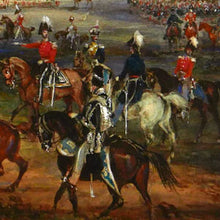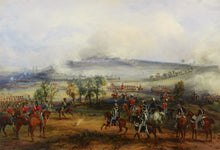The Black Watch - The Battle of Toulouse, 1814
Adding product to your cart
Overall: 49.5cm (19.4in) x 64cm (25.1in)
Exhibited Royal Society of British Artists, 1834-35.
Watercolour on paper. The attack on the French positions by the 6th Division of the Duke of Wellington's Army at the Battle of Toulouse fought on 10 April 1814. Attributed to Henry Martens after a sketch by Major M’Niven, 72nd Regiment. Framed and glazed,
Major M’Niven of the title was Major Thomas William Ogilvy McNiven who, as an Ensign in 42nd (Royal Highland) Regiment in 1814, was one of three Black Watch officers who were successively shot down carrying the 2nd Battalion’s King’s Colour into the enemy’s redoubt at the Battle of Toulouse. The colour was finally planted in the French position by a Sergeant. Only 90 out of the 500 men who crossed the start line were still with him at the finish. The 42nd and the 79th Highlanders were consequently two out of the four Regiments singled out for ‘highly distinguished service’ in Wellington's despatch after the battle.
Read more
Lieutenant-Colonel McNiven (1792-1870) was born in Banff and was commissioned Ensign on 23 July 1812. He landed in the Iberian Peninsula on December 1813 with 2nd Battalion, The Black Watch. He saw action at the investment of Bayonne, the battle of Orthes, action at Aire and at the battle of Toulouse in which the Highland Brigade under Sir Denis Pack played a prominent and bloody role, and where he was ‘severely wounded near the groin’. His sketch, ‘A View of the Contended Position at Toulouse, April 10th 1814’ on which the present work is clearly based is in the National Army Museum collection (NAM 1962-10-10). Another McNiven’s sketches, the ‘Attack of French Chasseurs on 42nd RH Regt at the Battle of Orthes February 1814’, is held by the Black Watch Museum, Balhousie Castle, Perth. McNiven was awarded a pension of £70 on account of his wound, and did not have the musket ball extracted until several years after the battle. He recovered to see later service in Gibraltar, Malta and Corfu. McNiven exhibited views of Elba and Paestum at the Society of British Artists in 1846, and, according to the UK, Government Art Collection, also gave sketches to other artists, such as Henry Martens, to be worked up into paintings. He became captain by purchase in the 29th Foot (Cameronians) in 1829. In 1840 he accompanied the British expedition to Syria as Assistant Adjutant-General. He died in 1870, whereupon the 42nd Regiment erected an obelisk in his memory in St Michael's Churchyard, Inveresk, Scotland.
 ‘A View of the Contended Position at Toulouse, April 10th 1814’ by McNiven (NAM)
‘A View of the Contended Position at Toulouse, April 10th 1814’ by McNiven (NAM)
Henry Martens (1790-1868) was born in London to German parents and became the leading military illustrator and artist of the 1830s and 40s. He worked mainly in watercolour although a few oil paintings are known. As with the present watercolour, Martens’s paintings were often based on sketches by veterans, such as his battle paintings of First Sikh War based on sketches by Major George White of the 31st Regiment. Martens is perhaps best known for the historical and contemporary works, such as ‘Costumes of the British Army’ (1848-1853,) that he created for the Anglo-German lithographer and publisher Rudolf Ackmermann who ran the Eclipse Sporting Gallery at 191 Regent Street. As with many other of his works these were engraved by John Harris. The London Commercial Directories for 1850-51 list ‘Henry Marten, artist,’ and locate his studio at 31 Conduit Street, Hanover Square, which was conveniently close to Ackermann’s gallery. The Post Office Directory for 1856 places him at 73 Stanhope Street, Hampstead Road. Martens worked mainly in watercolour although he exhibited a few oils at various galleries including the British Institution and the Society of British Artists. He exhibited pictures at various galleries including the British Institution and particularly at the Society of British Artists. Between 1828 and 1842, he showed no fewer than 34 watercolours at the latter, the majority depicting military scenes such as The Skirmish at Drumclog (1833–34), Out-post duty - English Hussars (1836), Charles I at the Battle of Naseby (1839) and Cavalry engagement at Benevente during Sir John Moore's Retreat (1842).






